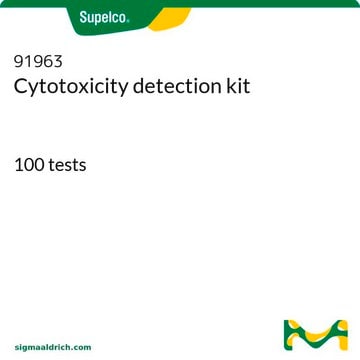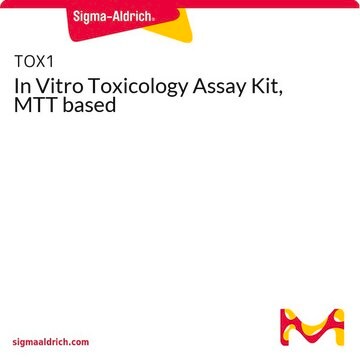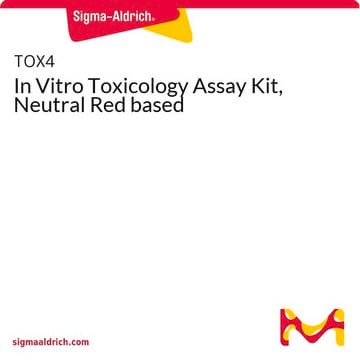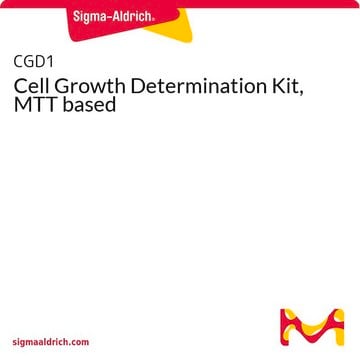11644793001
Roche
Cytotoxicity Detection Kit (LDH)
suitable for protein quantification, suitable for cell analysis, detection, sufficient for ≤2,000 tests
Synonym(s):
LDH
About This Item
Recommended Products
usage
sufficient for ≤2,000 tests
Quality Level
packaging
pkg of 1 kit
manufacturer/tradename
Roche
technique(s)
protein quantification: suitable
λmax
490 nm
application(s)
cell analysis
detection
detection method
colorimetric
storage temp.
−20°C
General description
Colorimetric assay for the quantification of cell death and cell lysis, based on the measurement of lactate dehydrogenase (LDH) activity released from the cytosol of damaged cells into the supernatant.
Application
- Detection and quantification of cell-mediated cytotoxicity
- Determination of mediator-induced cytolysis
- Determination of the cytotoxic potential of compounds in environmental and medical research, and in the food, cosmetic, and pharmaceutical industries
- Determination of cell death in bioreactors
- Testing of biocompatibility of various scaffolds, employed in bone tissue engineering, for bone cell growth
Packaging
Preparation Note
Reconstitute the lyophilisate in 1 ml double dist. water for 10 minutes and mix thoroughly.
Vial 2 Dye solution:
Ready-to-use solution.
Reaction mixture
For 100 tests: Shortly before use, mix 250 μl of vial 1 with 11.25 ml of vial 2.
For 400 tests: Shortly before use, add the total volume of catalyst (1 ml) to the total volume
of dye solution (45 ml) and mix well.
Note: The Reaction mixture should not be stored; prepare immediately before use.
Storage conditions (working solution): 2 to 8 °C
The lyophilizate is stable at 2 to 8 °C.
The reconstituted catalyst solution is stable for four weeks when stored at 2 to 8 °C.
Once thawed, the dye solution is stable for several weeks when stored at 2 to 8 °C.
Kit Components Only
- Catalyst (Diaphorase/NAD+ mixture)
- Dye Solution (INT and sodium lactate)
related product
Signal Word
Warning
Hazard Statements
Precautionary Statements
Hazard Classifications
Eye Irrit. 2
Storage Class Code
12 - Non Combustible Liquids
WGK
WGK 1
Flash Point(F)
does not flash
Flash Point(C)
does not flash
Certificates of Analysis (COA)
Search for Certificates of Analysis (COA) by entering the products Lot/Batch Number. Lot and Batch Numbers can be found on a product’s label following the words ‘Lot’ or ‘Batch’.
Already Own This Product?
Find documentation for the products that you have recently purchased in the Document Library.
Customers Also Viewed
Articles
Quality control guidelines to maintain high quality authenticated and contamination-free cell cultures. Free ECACC handbook download.
Quality control guidelines to maintain high quality authenticated and contamination-free cell cultures. Free ECACC handbook download.
Quality control guidelines to maintain high quality authenticated and contamination-free cell cultures. Free ECACC handbook download.
Quality control guidelines to maintain high quality authenticated and contamination-free cell cultures. Free ECACC handbook download.
Related Content
Cytotoxicity Detection Kit (LDH) Protocol & Troubleshooting
Our team of scientists has experience in all areas of research including Life Science, Material Science, Chemical Synthesis, Chromatography, Analytical and many others.
Contact Technical Service













